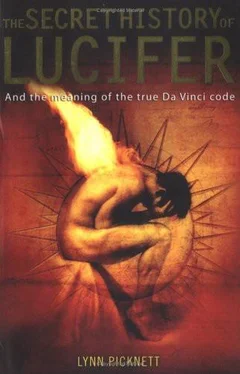While the canonical books are resolutely from what might be termed `mainstream' Christianity, or Saint Paul's version, these other works are mostly Gnostic in origin and outlook. The biblical Gospels try almost too hard to sound authentic, piling on detail upon detail of Christ's travel schedule, the people he met and healed, the accusations of his critics, the chronology of his arrest, torture and death. The Gnostic gospels are usually much more concerned with the teachings and the mysteries, with a distinctly transcendent, intuitive feel to them. More significantly perhaps, the biblical texts are very masculine in tone and outlook, while the Gnostics are considerably more feminine - largely because of their reverence for their heroine, Mary Magdalene. Her role becomes clearer: indeed, even a cursory glance through the Gospels of Philip, Thomas and Mary, and the later Pistis Sophia (FaithWisdom) will present an almost explosively different picture of Jesus and his mission.
Mary comes across as feisty, intelligent, and perhaps a little too assertive and even controlling for her own good. In the Pistis Sophia - almost comically - she insists repeatedly on taking centrestage in Jesus' lengthy question-and-answer session with his disciples, asking 39 of the 42 questions. Although other women such as Salome, Martha and Mary the Mother do occasionally participate, the text is littered not only with the phrase `and Mary continues again' but also with the increasingly bitter complaints of the men, who feel humiliated and angry at her pre-eminence. One disciple in particular feels dangerously irate. Peter explodes to Jesus: `My Lord, we will not endure this woman, for she taketh the opportunity from us and hath let none of us speak, but she [my emphasis] discourseth many times.' Any mild suspicion that Peter may have actually loathed the Magdalene is substantially reinforced by another passage from the Pistis Sophia in which Mary herself says to Jesus:
My Lord, my mind is ever understanding, at every time to come forward and set forth the solution of the words which [thou] hath uttered: but I am afraid of Peter, because he threatened me and hateth our sex 48 [My emphasis.]
Peter, the bluff hot-tempered `Big Fisherman' clearly absolutely detests Mary, saying to Jesus, `Lord, let Mary leave us, for women are not worthy of life'49 - although Christ's own reaction, as we shall see, is perhaps at first sight not as female-friendly as it might have been. But does Peter (and perhaps the other men in the mission) hate the Magdalene simply because she is a woman? Although married,50 Peter had no compunction in abandoning his wife to follow Jesus - he may have been glad to escape an unhappy home life - although in any case misogyny was a way of life to the Jews of his time and place.
The days of wine, roses and Asherath had long gone, the shekhina were desexed and Yahweh ruled with an impressively male rod of iron. Goddesses belonged to the louche foreigners, such as - or perhaps especially - the sophisticated Egyptians, and were therefore an abomination to the Lord. (When the Greeks tried to foist the new dyingand-rising god Serapis on them, the novel religion only took hold when the people's beloved Isis was restored to power and set at his right hand, a situation that was to be echoed, albeit feebly, when the Christians made Mary their Virgin goddess.)
To the likes of Simon Peter, women should know their place: in the home behind the cooking pot or washing the men's clothes, going submissively and silently about their business with their hair modestly tied up and veiled. On the other hand, the Magdalene was known to flout Jewish Law (being harmatolos) and custom, audaciously wearing her hair unbound in public - so grievous a social and religious sin that a man could divorce his wife for doing so. (Her unbound hair, with which she dried Jesus' feet, was probably a major reason for the male disciples' distaste at the anointing.) She unhesitatingly spoke up, even in the company of the `superior' men, and was one of the women who funded Jesus' mission. Clearly rich, independent and articulate, possessed of secrets the dim Peter could only guess at, the Magdalene was riding high among the cult members. In the Pistis Sophia she even permits herself the verbal equivalent of a sly wink at Jesus as she says with something approaching mock humility: `Be not wroth with me if I question thee on all things.' Jesus says `Question what thou wilt', so, seizing on a particular point of theology, she says with an unmistakable air of condescension, as initiate to initiate: `My Lord reveal unto us ... that also my brethren may understand it [My emphasis].'S1 Peter was ill-equipped to deal with a woman who was clearly already so well-informed about Jesus' secrets and who occasionally succumbed to the temptation to rub it in. But worse, it was she who was Jesus' favourite - and absolutely not Peter himself, as indicated in the New Testament. And her role in the resurrection was something of a stumbling block for the Church, which - unbelievably - claims its authority from the `fact' that its founder, Peter, was the first person to see the risen Christ. Even a brief glance at the story in the New Testament will reveal this is arrant rubbish, although the truth would have been considerably easier to keep from the flock in the days before widespread literacy.
The Gospel of Mark states plainly: `When Jesus rose early on the first day of the week, he appeared first to Mary Magdalene.'s' The Vatican still tries to wriggle out of this by explaining that Jesus had no female disciples: basically a spiritually inferior woman, Mary Magdalene didn't count. And as the argument about female bishops rolls on unedifyingly in the ranks of the Anglican Church, the old prejudices emerge with some degree of viciousness - of course women should not be bishops, or even priests, for it is a known fact that Jesus chose his disciples only from among the male population.
Yet even the male-oriented New Testament not only lists the women on the mission - always beginning with the Magdalene - but also describes them as `disciples', although unfortunately this telling term has traditionally been translated as 'disciples' of the men, but the more derogatory and inferior `followers' in a female context. In reality, it is the same word for the same role. In any case, according to Luke's Gospel, the women `were helping to support [Jesus and the men] of their own means'," or basically funding the men's mission. (The women must have been somewhat taken aback at Jesus' teaching `Consider how the lilies grow. They do not labour or spin,'S4 about not worrying about the future because God would provide. If he did, his bounty took the form of the purses of the daughters of Asherah.) The Magdalene and the other women essentially kept the men, and proved loyal to the end, while Peter got drunk, denied three times that he even knew Jesus and, like his brothers in the Gospel (apart from young John) was nowhere to be seen at the crucifixion. Surely the women had earned the right to be called disciples.
However, the Gnostic Gospels make explicit what was lurking implicitly in the New Testament about the status of the women, especially Mary Magdalene. These forbidden, anathematized books make it very clear that not only did Christ welcome women into his mission, but they were members of his inner circle of initiates rather than the slower-witted and unimaginative men, who time and time again `knew not what he meant', and even showed no sign of comprehending the significance of Christ's death. The impression is that Peter in particular had no idea what was going on: all he knew was that he loved Jesus and spent much of his time in a redhot passion of envy and anger at the - to him - incomprehensible status of the Magdalene. Of all the women, Magdalene, the Great Lady and anointing priestess, even earned the title `Apostle of the Apostles'," which implies that Jesus acknowledged she stood head and shoulders above all other apostles.
Читать дальше












